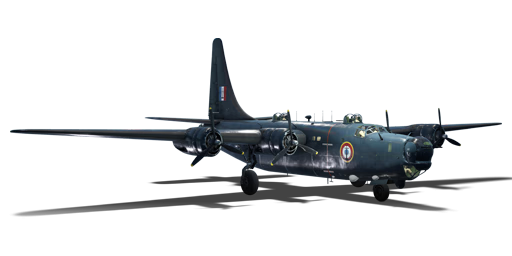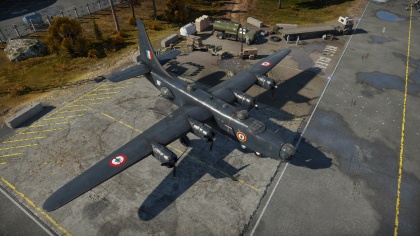Difference between revisions of "PB4Y-2 (France)"
CDT_GALAAD (talk | contribs) (Tag: Visual edit) |
|||
| Line 10: | Line 10: | ||
[[File:GarageImage_PB4Y-2France.jpg|420px|thumb|left]] | [[File:GarageImage_PB4Y-2France.jpg|420px|thumb|left]] | ||
{{break}} | {{break}} | ||
| − | The '''{{Specs|name}}''''' is a rank {{Specs|rank}} French heavy bomber {{Battle-rating}}. It was introduced in [[Update 1.73 "Vive la France"]]. | + | The '''{{Specs|name}}''''' is a rank {{Specs|rank}} French heavy bomber {{Battle-rating}}. It was introduced in [[Update 1.73 "Vive la France"]].'' |
== General info == | == General info == | ||
=== Flight Performance === | === Flight Performance === | ||
| − | <!--''Describe how the aircraft behaves in the air. Maximum speed, maneuverability, speed and allowable loads - these are the most important characteristics of the vehicle.''--> | + | The PB4Y-2 is a good but technical plane: the rate of climb is not bad for bombers and the carrying of the bombs is really good.<!--''Describe how the aircraft behaves in the air. Maximum speed, maneuverability, speed and allowable loads - these are the most important characteristics of the vehicle.''--> |
{| class="wikitable" style="text-align:center" | {| class="wikitable" style="text-align:center" | ||
|- | |- | ||
| Line 170: | Line 170: | ||
== Usage in the battles == | == Usage in the battles == | ||
| − | + | this plane have a good carrying : 4x 2 000lb bombs ; but for play this plane you must climb towards 5000/6000 m minimum on the side of the map, to avoid the enemy fighters who will arrive to you from the front if you do not climb. | |
| + | |||
| + | '''1 or 2 bombs destroyed 1 base in this br.''' | ||
===Manual Engine Control=== | ===Manual Engine Control=== | ||
| Line 238: | Line 240: | ||
== History == | == History == | ||
| − | + | In the first half of World War II, the US Navy, which needed a long-range land-based aircraft for the Maritime Patrol, made an agreement with the US Air Force for production sharing B-24 Liberator which was intended for him. | |
| + | |||
| + | At the very beginning of 1944, a variant of the B-24 with an elongated fuselage and a single fin was developed under the name PB4Y-2 and baptized Privateer. 736 copies were delivered to the United States Navy | ||
| + | |||
| + | It was built in two versions: PB4Y-2B, version intended for the bombardment, and PB4Y-2S intended for the anti submarine fight. | ||
| + | [[File:PB4Y 2 privateers in french flotille 28F.jpg|thumb|283x283px]] | ||
| + | |||
| + | It was in November 1950 that the Naval Aviation in Indochina received its first Privateers. These devices, delivered to type "S" (Anti Submarine Fight) had to be transformed to type "B" (bombardment) with installation of the Norden sight. Operational in the 8F (future 28F) squadron, they replaced the PBY-5A - Catalina in 1951. The Privateers also equipped the 24F flotilla for a few months (May to September 1954) at the height of the Indochinese conflict. | ||
| + | |||
| + | Their role in day and night bombing missions in Na-San as in Dien-Bien-Phu was decisive, even if the sacrifices made by the crews could not, in the end, influence the course of history... | ||
| + | |||
| + | They remained in service until 1960 at 28F squadron. | ||
== Media == | == Media == | ||
Revision as of 19:13, 1 April 2020
Contents
| This page is about the French heavy bomber PB4Y-2 (France). For other versions, see B-24/PB4Y (Family). |
Description
The ▄PB4Y-2 Privateer is a rank IV French heavy bomber
with a battle rating of 4.7 (AB/RB) and 5.7 (SB). It was introduced in Update 1.73 "Vive la France".
General info
Flight Performance
The PB4Y-2 is a good but technical plane: the rate of climb is not bad for bombers and the carrying of the bombs is really good.
| Characteristics | |||||||
|---|---|---|---|---|---|---|---|
| Stock | |||||||
| Max Speed (km/h at ?,000 m) |
Max altitude (meters) |
Turn time (seconds) |
Rate of climb (meters/second) |
Take-off run (meters) | |||
| AB | RB | AB | RB | AB | RB | ||
| ? | ? | 10000 | ??.? | ??.? | ??.? | ??.? | ??? |
| Upgraded | |||||||
| Max Speed (km/h at ?,000 m) |
Max altitude (meters) | Turn time (seconds) | Rate of climb (meters/second) |
Take-off run (meters) | |||
| AB | RB | AB | RB | AB | RB | ||
| ? | ? | 10000 | ??.? | ??.? | ?.? | ?.? | ? |
Details
| Features | ||||
|---|---|---|---|---|
| Combat flap | Take-off flap | Landing flap | Air brakes | Arrestor gear |
| X | X | X | X | X |
| Limits | ||||
|---|---|---|---|---|
| Wing-break speed (km/h) |
Gear limit (km/h) |
Combat flap (km/h) |
Max Static G | |
| + | - | |||
| ??? | ??? | ??? | ~?? | ~? |
| Optimal velocities | |||
|---|---|---|---|
| Ailerons (km/h) |
Rudder (km/h) |
Elevators (km/h) |
Radiator (km/h) |
| < ??? | < ??? | < ??? | > ??? |
| Compressor (RB/SB) | ||
|---|---|---|
| Setting 1 | ||
| Optimal altitude | 100% Engine power | WEP Engine power |
| ?,??? m | ??? hp | ?,??? hp |
Survivability and armour
- 38 mm Bulletproof glass in front of nose gunner.
- 12.7 mm Steel plate in front of nose gunner.
- 9.5 mm Steel plate underneath nose gunner.
- 9.5 mm Steel plates behind pilots.
- Three 9.5 mm Steel plates inside the fuselage.
- 9.5 mm Steel plates behind and under radial engines.
- 12.7 mm Steel plates behind dorsal gunners.
- 38 mm Bulletproof glass in front of beam gunners.
- 9.5 and 6.35 mm Steel plates in front of beam gunners.
- 55 mm Bulletproof glass in front of tail gunner.
- 9.5 mm Steel plate in front of tail gunner.
Armaments
Suspended armament
The PB4Y-2 (France) can be outfitted with the following ordinance:
- 20 x 100 lbs AN-M30A1 bombs (2,000 lb = total)
- 8 x 500 lbs AN-M64A1 bombs (4,000 lb = total)
- 4 x 1,000 lbs AN-M65A1 bombs (4,000 lb = total)
- 8 x 1,000 lbs AN-M65A1 bombs (8,000 lb = total)
- 4 x 2,000 lbs AN-M66A2 bombs (8,000 lb = total)
Defensive armament
The PB4Y-2 (France) is defended by:
- 2 x 12.7 mm M2 Browning machine gun, nose turret (600 RPGg = 1,200 total)
- 2 x 12.7 mm M2 Browning machine gun, 2 x dorsal turret (380 RPG = 1,520 total)
- 2 x 12.7 mm M2 Browning machine gun, 2 x beam turret (400 RPG = 1,600 total)
- 2 x 12.7 mm M2 Browning machine gun, tail turret (400 RPG = 800 total)
Usage in the battles
this plane have a good carrying : 4x 2 000lb bombs ; but for play this plane you must climb towards 5000/6000 m minimum on the side of the map, to avoid the enemy fighters who will arrive to you from the front if you do not climb.
1 or 2 bombs destroyed 1 base in this br.
Manual Engine Control
| MEC elements | ||||||
|---|---|---|---|---|---|---|
| Mixer | Pitch | Radiator | Supercharger | Turbocharger | ||
| Oil | Water | Type | ||||
| Not controllable | Controllable Automatic pitch |
Controllable | Not controllable | Combined | Controllable | Not controllable |
Modules
| Tier | Flight performance | Survivability | Weaponry |
|---|---|---|---|
| I | |||
| II | |||
| III | |||
| IV |
Pros and cons
Pros:
- Great defensive coverage
- Great defensive armament
- Good payload options when fully upgraded
Cons:
- Inadequate stock payload options
- Poor climb rate
- Very, very slow, especially when stock
- Tail can break off when landing and can be easily shot off
- Low dive limit and turn limit
History
In the first half of World War II, the US Navy, which needed a long-range land-based aircraft for the Maritime Patrol, made an agreement with the US Air Force for production sharing B-24 Liberator which was intended for him.
At the very beginning of 1944, a variant of the B-24 with an elongated fuselage and a single fin was developed under the name PB4Y-2 and baptized Privateer. 736 copies were delivered to the United States Navy
It was built in two versions: PB4Y-2B, version intended for the bombardment, and PB4Y-2S intended for the anti submarine fight.
It was in November 1950 that the Naval Aviation in Indochina received its first Privateers. These devices, delivered to type "S" (Anti Submarine Fight) had to be transformed to type "B" (bombardment) with installation of the Norden sight. Operational in the 8F (future 28F) squadron, they replaced the PBY-5A - Catalina in 1951. The Privateers also equipped the 24F flotilla for a few months (May to September 1954) at the height of the Indochinese conflict.
Their role in day and night bombing missions in Na-San as in Dien-Bien-Phu was decisive, even if the sacrifices made by the crews could not, in the end, influence the course of history...
They remained in service until 1960 at 28F squadron.
Media
An excellent addition to the article will be video guides, as well as screenshots from the game and photos.
Read also
Links to the articles on the War Thunder Wiki that you think will be useful for the reader, for example,
- reference to the series of the aircraft;
- links to approximate analogues of other nations and research trees.
Sources
Paste links to sources and external resources, such as:
- topic on the official game forum;
- page on aircraft encyclopedia;
- other literature.
| Consolidated Aircraft Corporation | |
|---|---|
| Bombers | PBY-5 Catalina · PBY-5A Catalina |
| PB4Y-2 | |
| B-24D-25-CO | |
| Export | ▄Catalina Mk IIIa · ▂PBY-5A Catalina · ▄PBY-5A Late · ␗PB4Y-2 · ▄PB4Y-2 |
| France bombers | |
|---|---|
| Farman | F.222.2 · N.C.223.3 |
| Latécoère | Late 298D |
| Potez | Potez 633 |
| Liore et Olivier | LeO 451 early · LeO 451 late |
| Bloch | M.B.174A-3 · M.B.162 · M.B.175T |
| American | V-156-F · Martin 167-A3 · ▄A-35B · ▄SB2C-5 · B-26C · ▄PBY-5A Late · ▄PB4Y-2 |
| British | Lancaster MR.7 |





